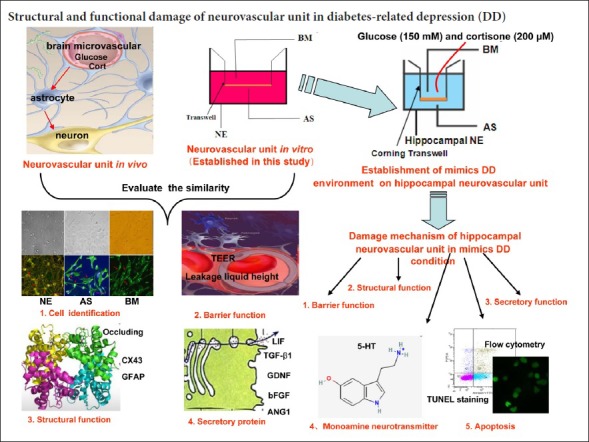- Record: found
- Abstract: found
- Article: found
Structural and functional damage to the hippocampal neurovascular unit in diabetes-related depression

Read this article at
Abstract

Abstract
Previous studies have shown that models of depression exhibit structural and functional changes to the neurovascular unit. Thus, we hypothesized that diabetes-related depression might be associated with damage to the hippocampal neurovascular unit. To test this hypothesis, neurons, astrocytes and endothelial cells were isolated from the brain tissues of rat embryos and newborn rats. Hippocampal neurovascular unit co-cultures were produced using the Transwell chamber co-culture system. A model of diabetes-related depression was generated by adding 150 mM glucose and 200 μM corticosterone to the culture system and compared with the neuron + astrocyte and astrocyte + endothelial cell co-culture systems. Western blot assay was used to measure levels of structural proteins in the hippocampal neurovascular unit co-culture system. Levels of basic fibroblast growth factor, angiogenic factor 1, glial cell line–derived neurotrophic factor, transforming growth factor β1, leukemia inhibitory factor and 5-hydroxytryptamine in the hippocampal neurovascular unit co-culture system were measured by enzyme-linked immunosorbent assay. Flow cytometry and terminal deoxynucleotidyl transferase (TdT)-mediated dUTP nick end labeling staining was used to assess neuronal apoptosis in the hippocampal neurovascular unit. The neurovascular unit triple cell co-culture system had better barrier function and higher levels of structural and secretory proteins than the double cell co-culture systems. In comparison, in the model of diabetes-related depression, the neurovascular unit was damaged with decreased barrier function, poor structural integrity and impaired secretory function. Moreover, neuronal apoptosis was markedly increased, and 5-hydroxytryptamine levels were reduced. These results suggest that diabetes-related depression is associated with structural and functional damage to the neurovascular unit. Our findings provide a foundation for further studies on the pathogenesis of diabetes-related depression.
Related collections
Most cited references24
- Record: found
- Abstract: found
- Article: not found
A new blood-brain barrier model using primary rat brain endothelial cells, pericytes and astrocytes.
- Record: found
- Abstract: found
- Article: not found
Should we screen for emotional distress in type 2 diabetes mellitus?
- Record: found
- Abstract: found
- Article: not found